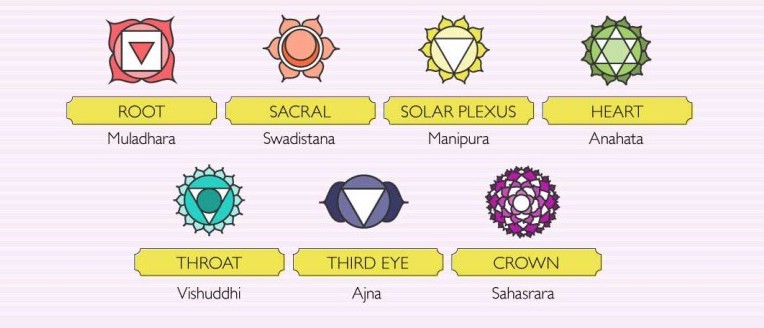Email. Whoosh. Facebook notification. Poke. Instagram notification. Ding. My life has become a never ending adrenaline rush of alerts, breaking up the day into fragments of cat videos, urgent chats, and pings. Finding a true retreat away from that chaos has required searching far corners of the earth for calm.
Mindfulness
Growing up in the West, venturing into Eastern philosophy hardly seems natural and may even be counterintuitive. Mindfulness, meditation, and yoga are all examples of similar practices adopted by Western culture over time.
Research has indicated a reduction in stress levels following mindfulness therapy. Instilling mindfulness even changes the brain, rivaling the effects of antidepressants in those with anxiety.
In urban areas filled with traffic and urgency, yoga studios have become a popular respite from a long day of work. Beyond straining to hold yoga poses, yoga at its highest level is a form of mindfulness meditation, listening to your own body and being present with yourself. Few beginners realize that the foundation of yoga lies in the chakras.
Chakras Defined
Chakras were first discussed 2000 years ago in Hindu texts. Each individual chakra serves as a focal point for energy within the body. In Sanskrit, Chakra actually means “wheel”, particularly fitting since the chakras amount to a network of connected energy centers throughout the body.
Blocked chakras interfere with functions of the body, leaving the body out of order and potentially causing physical or emotional imbalances.
The 7 chakras
Click for full infographic
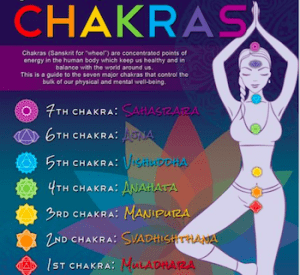
The 7 chakras are otherwise known as:
- 7th Chakra: Sahasrara
- 6th Chakra: Ajna
- 5th Chakra: Vishuddha
- 4th Chakra:Anahata
- 3rd Chakra:Manipura
- 2nd Chakra: Svadhisthana
- 1st Chakra: Muladhara
Colors
Click for full infographic
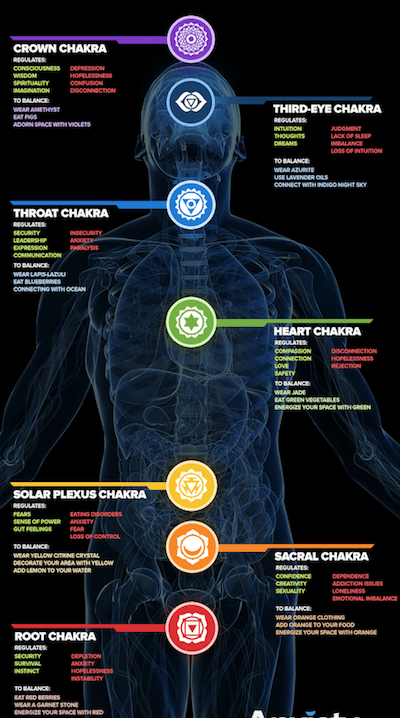
Having practiced long term yoga and meditation, I personally like to think of this having to do with research showing visualization techniques improving meditation. Adding colors strengthens our ability to visualize and focus.

Location and Meanings
Click for full infographic
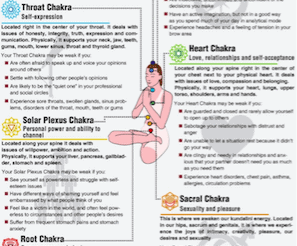
- Top of the Head: The Crown Chakra = Consciousness
- Forehead: The Third Eye = Inspiration, Intelligence
- Throat: The Throat Chakra = Self expression
- Lower Abdomen: The Heart Chakra = Love, relationships
- Stomach:The Solar Plexus Chakra = Self confidence, ego
- Lower Abdomen: The Sacral Chakra = Emotional identity, creativity
- Base of the Spine: The Root Chakra = Physical identity, survival
The 7 chakras in the human body and the Get to know your chakras infographics both offer descriptions of the potential impact of a weak or blocked chakras. Reading through the list can be a bit daunting – Chakras can influence physical maladies ranging from sleep problems, swollen glands, and hearing issues to ulcers, constipation, lower back pain, and even immune disorders. Emotionally they can influence anger, self-esteem, anxiety, hopelessness, and mood swings, to name a few.
Living a life free of any of the ailments listed would be a tall order – According to WebMD nearly 80% of Americans will experience back pain at some point. With the increasing use of computers neck and shoulder pain seems increasingly common also, and professionals often try yoga to combat the pain.
Goal of Yoga
Ever caught yourself in a yoga class frustrated by the poses that require Olympic training to hold, unable to stop the thoughts racing through your head? Yoga is ultimately a practice to find inner peace, though of course many students want to benefit from the physical intensity, improving flexibility and endurance.
Few beginners actually consider the concept of opening their chakras as the basis of yoga. But yoga was created as a means of balancing the chakras, while challenging the body and mind.
What exactly does it mean to balance the chakras? We all may have been born with open chakras, but if some of them became closed or inactive, others became overactive to compensate, creating an imbalance.
Take for an example the Sacral Chakra, which is located below the belly button. It can influence emotions, pleasure, and sexuality. Problems with this chakra can cause lower back pain, digestive problems, or intimacy issues.
Click for full infographic
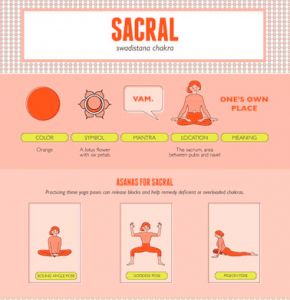
Even Nickelodeon has offered a simplified explanation of opening chakras:
Conclusion
Whether or not you decide to use this theory, the general idea of opening up areas of the body and stretching has a meaningful physical impact. At home you can use this 20 minute full body yoga workout guide.
I do believe in the power of the visualizing goals to achieve them. If yoga has just become something you do to tick the box, it’s worth spending some time understanding its purpose. The clarity that comes with it is breathtaking.

